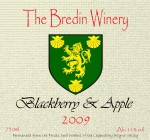Continuing from: Elderberry Wine 2009. Part 2 – Making the Must
About twelve hours after pitching the yeast the first signs of fermentation occur, a fizzling effervescence is audible and the yeast cake starts to form. The yeast cake is a spongy foam with the texture of blancmange that forms on top of the Must at the initial stages of Primary Fermentation. It helps protect the Must from oxidation as the rate at which Co2 is produced and given off is great enough to keep any air out.
The Primary Fermentation is an Aerobic Fermentation (conducted in the presence of air) and the yeast quickly reproduces to a concentration which enables a speedier conversion of the sugars to alcohol. Technically, very little fermentation actually occurs as the yeast multiplies so a more correct term for primary fermentation could be Aerobic Growth.
During Primary Fermentation the Must is kept closely covered, not airtight as this will prevent the aerobic fermentation from happening, but just enough to keep the number one enemy of the winemaker, the Wine Fly, at bay.
I don’t know what it is about Wine Flies, you won’t see one from one end of the year to the other but as soon as you start to ferment some wine or beer, they mysteriously appear from nowhere and hover around your brew just waiting for you to slip up and let them at your wine where they can deposit their eggs. The larvae from just one fly is enough to acetify an entire wine batch. It’s always good practice to thoroughly check around the fermentation vessel for wine flies before opening it to take any measurements.
After about four days in primary fermentation or when the Specific Gravity gets to around 1.020 it’s time to proceed to Secondary, Anaerobic fermentation.
I took an SG reading of 1.023 so I removed the straining bag that contained the pomace (left over skins and seeds), hung it over the fermentation vessel and gently squeezed making sure I got every last drop of wine from the bag. With the pomace removed, the volume of wine was just over 4 gallons.
To this I added a syrup at the right temperature (25 C) containing the last 750g of sugar, that I’d kept aside from making the Must and topped it up to a volume just above the five gallon mark, gently stirred it, syphoned the entire batch into my secondary fermentation vessel (carboy), added the oak chips (for those delicious vanilla flavours and tannins), sealed it up airtight and fitted the airlock.
Syphoning the wine into the carboy gave me the added bonus of getting an early taste of the wine. Tasting at this early stage can give some indications as to how it will eventually turn out but more importantly will definitely give an indication if anything untoward has happened in the process so far. A vinegary taste and acetification has occurred and unfortunately the whole batch will have to be dumped, or a bitter flavour could have meant that many of the seeds in the berries had burst, but the taste is intensely fruity and slightly sweet, exactly how it should be at this stage.
Secondary Fermentation (Anaerobic Fermentation) takes place in the absence of air and is a lot slower than primary fermentation. The carboy is sealed airtight and capped with an airlock which lets the CO2 thats produced during fermentation out but prevents the air from outside getting in and oxidising the wine. Fermentation activity is marked with the satisfying and rythymic ‘blup…blup…blup’ of the water in the airlock as the Co2 escapes. During secondary fermentation as the yeast cells convert the sugar to alcohol they die off, sink to the bottom of the carboy and form the Lees.
Daily SG readings are taken, waiting for the moment when the FG (Final Gravity) stabilizes (three consecutive daily readings) at about 1.000-990 for a dry wine.














